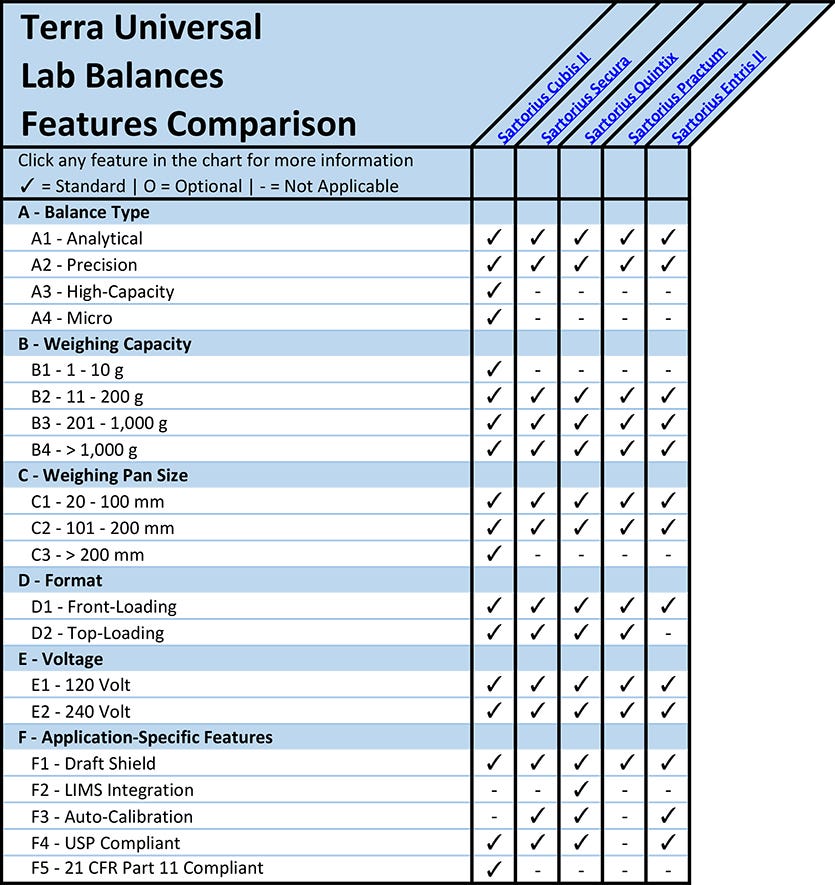
Lab Balances and Scales Feature Comparison

Uses for Balances in Laboratories
Lab balances and scales are offered in a variety of designs to measure sample mass, density, and moisture content of solids, liquids, and powders. While a scale determines the mass of a sample, a balance is designed to compare the mass of multiple samples. Balances and scales are offered in several configurations: analytical, precision, top-loading, front-loading, high-capacity and moisture analysis.
What types of Balances are Used in a Laboratory?
Certain balances offer additional functionality, such as data traceability (for 21CFR Part 11 compliance), integration with external devices (such as a printer, computer, or barcode reader), pipette calibration, and sample protection (such as a draft shield) for installation into a laminar flow hood or ISO-rated cleanroom.
A - Balance Type
(back to chart)
A1 - Analytical Balances
Analytical balances are optimal for most standard lab weighing operations, such as density determination, comparative mass analysis and dynamic weighing. Analytical balances measure samples to very tight tolerances, yielding readabilities down to 0.0001 grams. As analytical scales are sensitive to air current and temperature changes, most models include a draft shield to maintain a controlled measuring environment.
A2 - Precision Balances
Precision balances are an economical alternative to analytical balances. While precision scales support higher weight capacities than analytical models, they do not yield similar tolerances (readabilities down to 0.001 grams). Precision scales produce stable readings within environments experiencing temperature and humidity fluctuations.
A3 - High-Capacity Balances
High-capacity balances are designed to weigh bulk powders, animals, and heavy storage containers in production environments. While analytical and precision balances accommodate weight loads of 300 grams and 600 grams respectively, high-capacity balances can measure loads up to 34,000 grams.
A4 - Micro Balances
Microbalances are designed to weigh small samples (up to 6 grams) at industry-leading tolerances (readabilities down to 0.0000001 grams). Microbalances are extremely sensitive to changes in atmospheric conditions and require recalibration on a semi-annual basis.
B - Scale and Balance Weighing Capacity
(back to chart)
Laboratory balances offer a broad range of weighing capacities, from ultra-micro scales designed to measure down to the milligram and microgram levels, to high-capacity balances capable of measuring weights up to 34,000 grams. Electronic scales provide readouts in dozens of different units, including grams, milligrams, kilograms, pounds, ounces and grains.
C - Balance Weighing Pan Size
(back to chart)
Laboratory balances and scales include weighing pans to accommodate a variety of sample types, including powders, liquids, solids and living organisms. Smaller, round pans are optimal for weighing low quantities of aqueous samples or powders, while larger, square pans are ideal for weighing solids or tare vessels (such as weight buckets).
D - Balancing Loading and Format
(back to chart)
D1 - Front-Loading Balances
Front-loading balances include draft shields to protect the sample from air movement and temperature fluctuations. Ionizer draft shields dissipate static charges to protect fine powders from aggregating to draft shield walls.
D2 - Top-Loading Balances
Top-loading balances are designed without a draft shield to provide easy access to the weighing pan. Top-loading scales are optimal for weighing bulky solids, animals, or large containers that require unobstructed access to the weighing pan.
F - Application-Specific Features
(back to chart)
F1 - Balance Draft Shields
Sartorius Modular Cubis II Micro and Ultra-Micro Balances are available with glass or stainless steel draft shields. Draft shields offer protection for fine powders or aqueous samples sensitive to air currents or static charges. Common draft shields provide access to the weighing pan from the front, top and sides.
F2 - LIMS Integration
Sartorius Quintix balances offer data export programs compatible with a variety of software packages, including Microsoft Office and LIMS (Laboratory Information Management System), to support sample lot traceability, workflow efficiency, and event reporting.
F3 - Auto Calibration of Balances
Sartorius Secura and Quintix balances include isoCAL software to support automatic or user-determined instrument recalibration routines at monthly intervals or after balance relocation.
F4 - USP Compliance
Sartorius Cubis II (PDF), Quintix, and Secura balances automatically log all recorded measurements for daily export and review per USP <797> and <800> guidelines.
F5 - 21CFR Part 11 Compliance
The Sartorius Cubis II balance includes end-to-end data integrity, safe data transfer, electronic signatures for controlled data access, and audit trailing for 21CFR Part 11 compliance.
Buy Online: Cubis II Ultra-Micro and Microbalances by Sartorius
Where Can I Find a Trusted Supplier of Lab Balances and Other Laboratory Equipment?
Laboratory-Equipment.com is a specialty division of Terra Universal. For nearly 40 years, Terra Universal has served semiconductor, aerospace, life science, pharmaceutical, biotechnology, and medical device markets. Customers appreciate a worldwide network of reps, factory-direct support, and ready-to-ship items available from Terra's manufacturing and warehouse facilities in Fullerton, California.
Shop online to compare pricing, features, and selection for a wide variety of lab balances and equipment for applications including PCR, DNA/RNA techniques, ELISA, protein analysis, and cell culture.
Terra Universal is the leading expert in the design and fabrication of ISO rated cleanrooms, furnishing and supplies.
Get a free consultation from one of our cleanroom specialists:
Call (714) 459-0731


